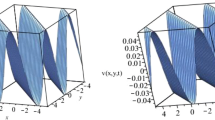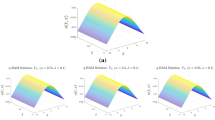Abstract
In this paper, a solution of coupled fractional Navier–Stokes equation is computed numerically using the proposed q-homotopy analysis transform method (q-HATM), and the solution is found in fast convergent series. The given test examples illustrate the leverage and effectiveness of the proposed technique. The obtained results are demonstrated graphically. The present method handles the series solution in a large admissible domain in an extreme manner. It offers us a modest way to adjust the convergence region of the solution. Results with graphs explicitly reveal the efficiency and capability of the proposed algorithm.
























Similar content being viewed by others
References
J H He, Int. J. Theor. Phys. 53(11), 3698 (2014)
F J Liu, H Y Liu, Z B Li and J H He, Therm. Sci. 21, 1867 (2017)
J H He, Results Phys. 10, 272 (2018)
D Tripathi, Acta Astonantaut. 68(7–8), 1379 (2011)
V E Tarasov, Ann. Phys. 323(11), 2756 (2008)
M Mirzazadeh, Pramana – J. Phys. 86(5), 957 (2016)
I Podlubny, Fractional differential equations (Academic Press, New York, 1999)
K S Miller and B Ross, An introduction to fractional calculus and fractional differential equations (Wiley-Blackwell, New York, 1993)
A A Kilbas, H M Srivastava and J J Trujillo, Theory and applications of fractional differential equations (Elsevier, Amsterdam, 2006)
A Prakash, M Goyal and S Gupta, Nonlinear Eng. 8, 164 (2019), https://doi.org/10.1515/nleng-2018-0001
A Prakash, M Goyal and S Gupta, Pramana – J. Phys. 92: 18 (2019), https://doi.org/10.1007/s12043-018-1683-1
M El-Shahed and A Salem, Appl. Math. Comput. 156(1), 287 (2004)
B K Singh and P Kumar, Ain Shams Eng. J. 9(4), 827 (2018), https://doi.org/10.1016/j.asej.2016.04.009
G A Birajdar, Nonlinear Eng. 3(1), 21 (2014)
D Kumar, J Singh and S Kumar, J. Assoc. Arab Univ. Basic Appl. Sci. 17, 14 (2015)
S J Liao, Appl. Math. Comput. 147(2), 499 (2004)
A Prakash and H Kaur, Chaos Solitons Fractals 105, 99 (2017)
H M Srivastava, D Kumar and J Singh, Appl. Math. Model. 45, 192 (2017)
D Kumar, J Singh and D Baleanu, Nonlinear Dyn. 91, 307 (2018)
J Singh, D Kumar and R Swaroop, Alexandria Eng. J. 55(2), 1753 (2016)
Acknowledgements
The authors are thankful to the reviewers and the editor for their valuable suggestions and comments to improve the quality of the paper.
Author information
Authors and Affiliations
Corresponding author
Rights and permissions
About this article
Cite this article
Prakash, A., Veeresha, P., Prakasha, D.G. et al. A new efficient technique for solving fractional coupled Navier–Stokes equations using q-homotopy analysis transform method. Pramana - J Phys 93, 6 (2019). https://doi.org/10.1007/s12043-019-1763-x
Received:
Revised:
Accepted:
Published:
DOI: https://doi.org/10.1007/s12043-019-1763-x
Keywords
- Navier–Stokes equations
- q-homotopy analysis transform method
- Caputo fractional derivative
- Laplace transform
- homotopy analysis method




